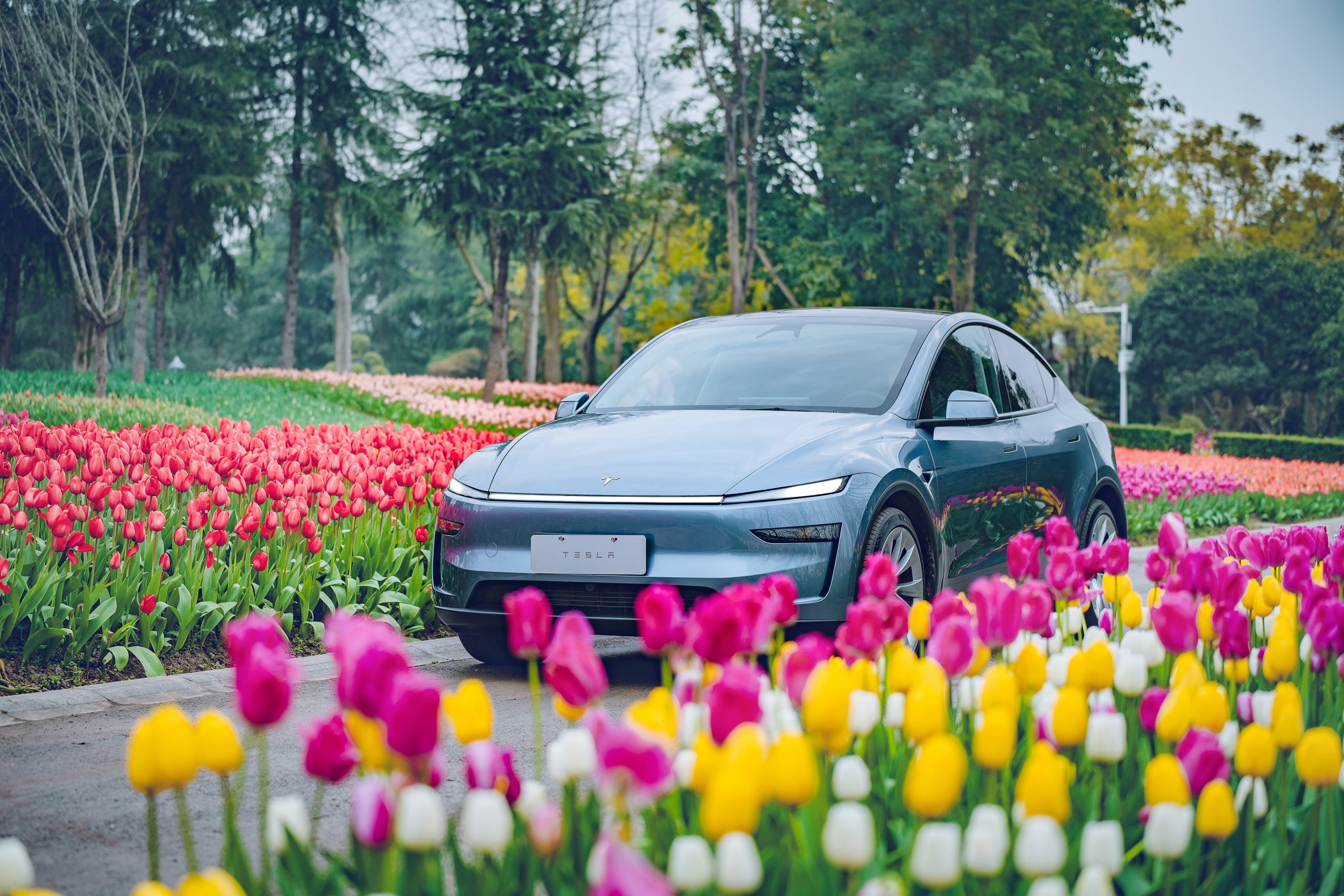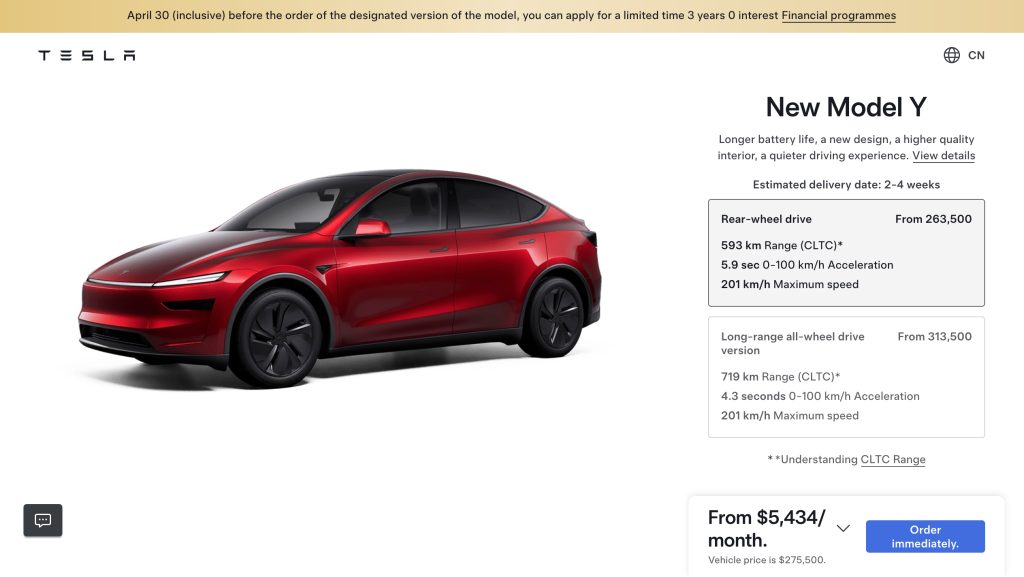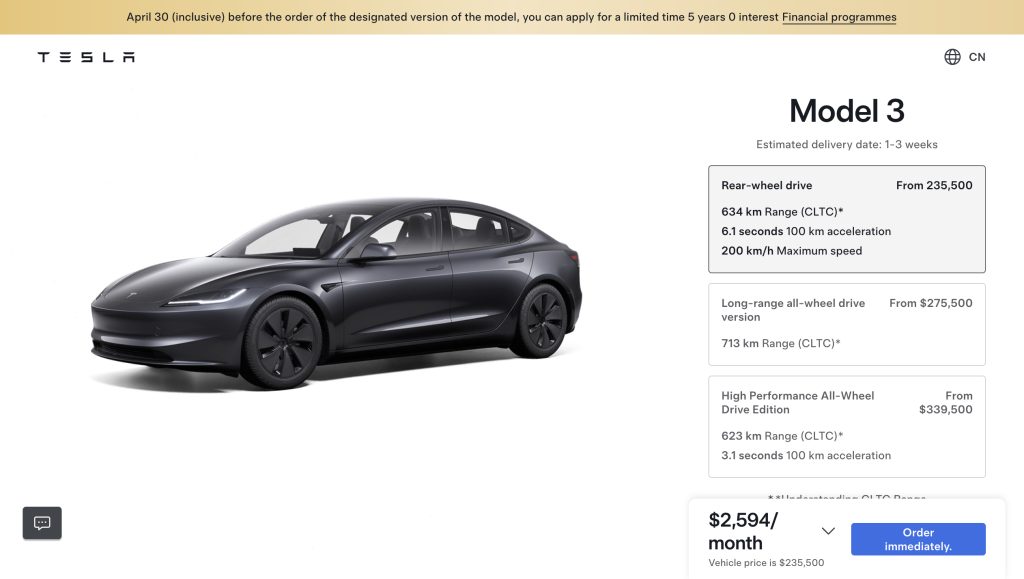News
Tesla China launches new low-interest promos on Model Y, Model 3
New zero- and low-interest financing terms arrive for both the Tesla Model Y and Model 3.

Tesla China has launched new promotions on the recently released Model Y refresh and the Model 3, offering special zero-interest loans for the next few weeks.
On Monday, Tesla began offering zero-interest loans with one- to three-year terms on purchases of the new Model Y, available between April 1 and 30 on the company’s order configurator. In addition, the automaker is offering a one- to five-year interest plan with annual rates as low as 1 percent when buyers make a down payment of at least RMB 45,900 (~$6,325).
Tesla China’s April 2025 Model Y promotions

Credit: Tesla China
You can read more details on Tesla China’s zero-interest promotion below, as detailed on the order configurator page and translated into English from Chinese.
Rejuvenated Model Y rear-wheel drive version, long-range all-wheel drive version – limited-time 0-interest/low-interest loan scheme
Customers who purchase the new Model Y rear-wheel-drive version/long-range all-wheel drive version/long range during the event from April 1, 2025 to April 30, 2025, and deliver and pay in the order before the expiration date of the vehicle, customers who meet the application qualification can apply for the following financial preferential schemes:
-
- Starting from RMB 79,900, you can enjoy a 1 to 3 year 0 interest plan
- From the down payment of RMB 45,900, you can enjoy a 1- to 5-year low-interest program with an annual rate of 1.00 percent (from 1.84 percent).
Tesla China’s April 2025 Model 3 promotions

Credit: Tesla China
The company is also offering five-year, zero-interest financing for the Model 3 RWD and AWD Long Range, and you can see the terms for the zero- and low-interest Model 3 promotions and others below:
Model 3 rear-wheel drive version, long-range all-wheel drive version – limited-time 0-interest/low-interest loan solution
Customers who purchase a designated version of the Model 3, long-range all-wheel-drive version, long-range all-wheel-drive version, and delivery and payment terms in the order during the event from April 1, 2025 to April 30, 2025, customers who meet the eligibility requirements can apply for the following financial preferential schemes:
-
- Starting at RMB 79,900, you can enjoy a 1 to 5 year 0 interest plan
- Starting from RMB 45,900, you can enjoy a 1 to 5 year low interest program with an annual rate of 0.5 percent (from 0.92 percent per annum)
Additionally, Model 3 buyers can get discounted rates on home charging equipment, or a six-year Supercharging package offering up to 30,000km (~18,641 miles) of charging for free.
Tesla posts an onboarding tutorial video for its customers in China, starring the new Model Y.
Here comes the new Model Y ramp!pic.twitter.com/Dm8NQsdQGj
— TESLARATI (@Teslarati) March 5, 2025
READ MORE ON TESLA CHINA: Tesla China seems to have overtaken Q1 2024’s registrations with new Model Y ramp
Tesla first launched the refreshed Model Y in China in January, debuting the refaced vehicle with a special “Launch Edition” series that came with special badging and an extra two years or 40,000km (~24,855 miles) of warranty time. Deliveries of the Launch Edition Model Y began in China late last month, and Tesla officially transitioned to selling non-Launch models in the first few days of March.
For the Chinese market and several others, Tesla produces the Model Y and Model 3 at a Gigafactory in Shanghai. In recent weeks, reports have suggested that Giga Shanghai may also be looking to produce an even cheaper version of the new Model Y without some of the extra add-ons, perhaps not unlike the cheaper Model 3 that launched in Mexico last August.

News
Tesla FSD fleet is nearing 7 billion total miles, including 2.5 billion city miles
As can be seen on Tesla’s official FSD webpage, vehicles equipped with the system have now navigated over 6.99 billion miles.

Tesla’s Full Self-Driving (Supervised) fleet is closing in on almost 7 billion total miles driven, as per data posted by the company on its official FSD webpage.
These figures hint at the massive scale of data fueling Tesla’s rapid FSD improvements, which have been quite notable as of late.
FSD mileage milestones
As can be seen on Tesla’s official FSD webpage, vehicles equipped with the system have now navigated over 6.99 billion miles. Tesla owner and avid FSD tester Whole Mars Catalog also shared a screenshot indicating that from the nearly 7 billion miles traveled by the FSD fleet, more than 2.5 billion miles were driven inside cities.
City miles are particularly valuable for complex urban scenarios like unprotected turns, pedestrian interactions, and traffic lights. This is also the difference-maker for FSD, as only complex solutions, such as Waymo’s self-driving taxis, operate similarly on inner-city streets. And even then, incidents such as the San Francisco blackouts have proven challenging for sensor-rich vehicles like Waymos.
Tesla’s data edge
Tesla has a number of advantages in the autonomous vehicle sector, one of which is the size of its fleet and the number of vehicles training FSD on real-world roads. Tesla’s nearly 7 billion FSD miles then allow the company to roll out updates that make its vehicles behave like they are being driven by experienced drivers, even if they are operating on their own.
So notable are Tesla’s improvements to FSD that NVIDIA Director of Robotics Jim Fan, after experiencing FSD v14, noted that the system is the first AI that passes what he described as a “Physical Turing Test.”
“Despite knowing exactly how robot learning works, I still find it magical watching the steering wheel turn by itself. First it feels surreal, next it becomes routine. Then, like the smartphone, taking it away actively hurts. This is how humanity gets rewired and glued to god-like technologies,” Fan wrote in a post on X.
News
Tesla starts showing how FSD will change lives in Europe
Local officials tested the system on narrow country roads and were impressed by FSD’s smooth, human-like driving, with some calling the service a game-changer for everyday life in areas that are far from urban centers.

Tesla has launched Europe’s first public shuttle service using Full Self-Driving (Supervised) in the rural Eifelkreis Bitburg-Prüm region of Germany, demonstrating how the technology can restore independence and mobility for people who struggle with limited transport options.
Local officials tested the system on narrow country roads and were impressed by FSD’s smooth, human-like driving, with some calling the service a game-changer for everyday life in areas that are far from urban centers.
Officials see real impact on rural residents
Arzfeld Mayor Johannes Kuhl and District Administrator Andreas Kruppert personally tested the Tesla shuttle service. This allowed them to see just how well FSD navigated winding lanes and rural roads confidently. Kruppert said, “Autonomous driving sounds like science fiction to many, but we simply see here that it works totally well in rural regions too.” Kuhl, for his part, also noted that FSD “feels like a very experienced driver.”
The pilot complements the area’s “Citizen Bus” program, which provides on-demand rides for elderly residents who can no longer drive themselves. Tesla Europe shared a video of a demonstration of the service, highlighting how FSD gives people their freedom back, even in places where public transport is not as prevalent.
What the Ministry for Economic Affairs and Transport says
Rhineland-Palatinate’s Minister Daniela Schmitt supported the project, praising the collaboration that made this “first of its kind in Europe” possible. As per the ministry, the rural rollout for the service shows FSD’s potential beyond major cities, and it delivers tangible benefits like grocery runs, doctor visits, and social connections for isolated residents.
“Reliable and flexible mobility is especially vital in rural areas. With the launch of a shuttle service using self-driving vehicles (FSD supervised) by Tesla in the Eifelkreis Bitburg-Prüm, an innovative pilot project is now getting underway that complements local community bus services. It is the first project of its kind in Europe.
“The result is a real gain for rural mobility: greater accessibility, more flexibility and tangible benefits for everyday life. A strong signal for innovation, cooperation and future-oriented mobility beyond urban centers,” the ministry wrote in a LinkedIn post.
News
Tesla China quietly posts Robotaxi-related job listing
Tesla China is currently seeking a Low Voltage Electrical Engineer to work on circuit board design for the company’s autonomous vehicles.

Tesla has posted a new job listing in Shanghai explicitly tied to its Robotaxi program, fueling speculation that the company is preparing to launch its dedicated autonomous ride-hailing service in China.
As noted in the listing, Tesla China is currently seeking a Low Voltage Electrical Engineer to work on circuit board design for the company’s autonomous vehicles.
Robotaxi-specific role
The listing, which was shared on social media platform X by industry watcher @tslaming, suggested that Tesla China is looking to fill the role urgently. The job listing itself specifically mentions that the person hired for the role will be working on the Low Voltage Hardware team, which would design the circuit boards that would serve as the nervous system of the Robotaxi.
Key tasks for the role, as indicated in the job listing, include collaboration with PCB layout, firmware, mechanical, program management, and validation teams, among other responsibilities. The role is based in Shanghai.
China Robotaxi launch
China represents a massive potential market for robotaxis, with its dense urban centers and supportive policies in select cities. Tesla has limited permission to roll out FSD in the country, though despite this, its vehicles have been hailed as among the best in the market when it comes to autonomous features. So far, at least, it appears that China supports Tesla’s FSD and Robotaxi rollout.
This was hinted at in November, when Tesla brought the Cybercab to the 8th China International Import Expo (CIIE) in Shanghai, marking the first time that the autonomous two-seater was brought to the Asia-Pacific region. The vehicle, despite not having a release date in China, received a significant amount of interest among the event’s attendees.








